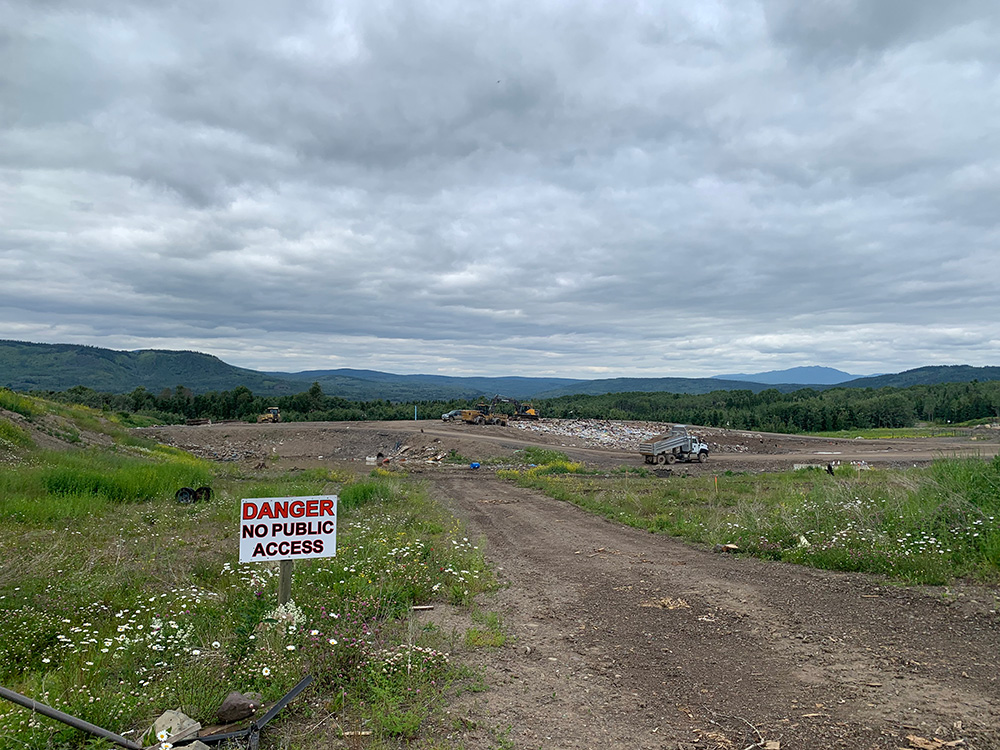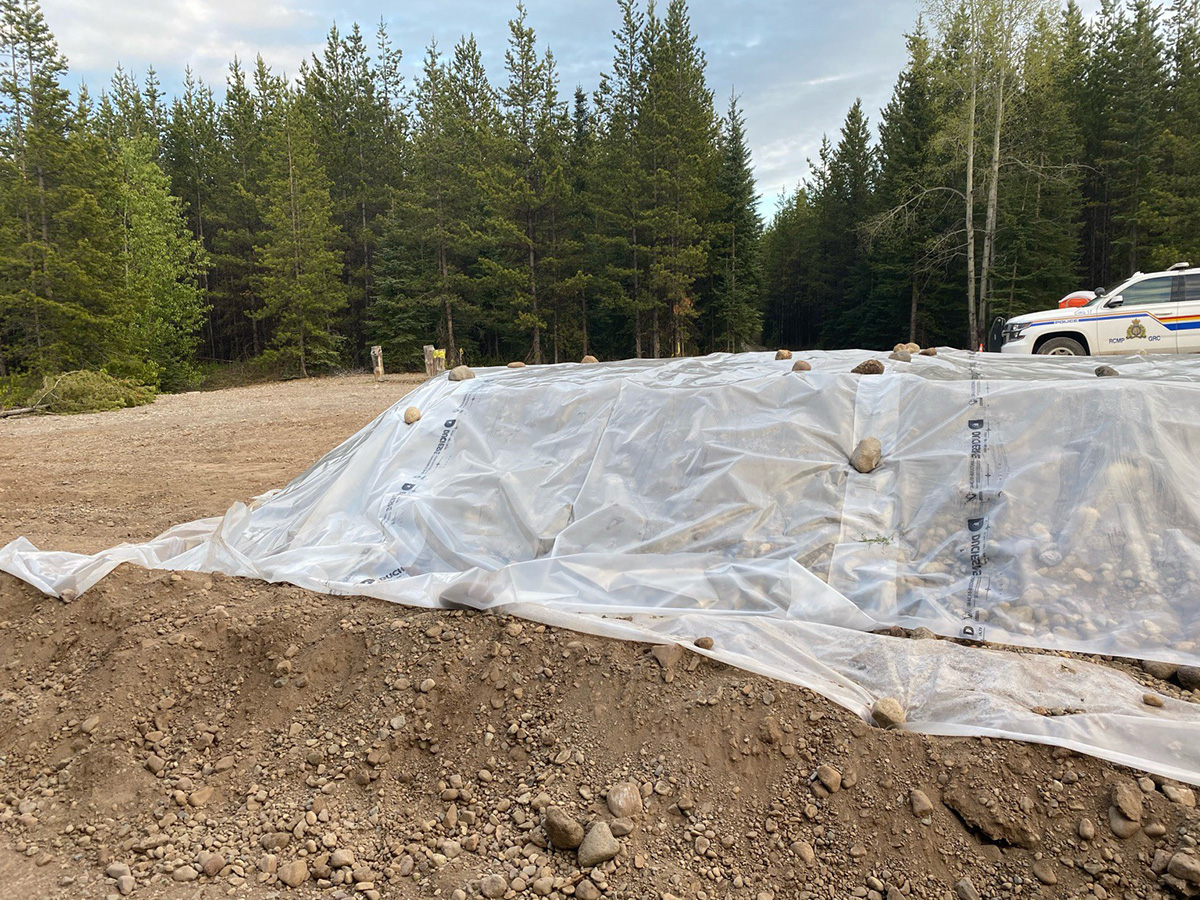Efforts to clean up diesel spills by the RCMP and Coastal GasLink in Wet’suwet’en territory risk spreading the contamination, the First Nation has warned.
Mike Ridsdale, environmental assessment co-ordinator for the Office of the Wet’suwet’en, the central office for the nation, said the waste is being moved to a nearby landfill where it will still pose a threat.
“We’ve had two spills where the contaminants were knowingly moved into another watershed and are now threatening our water,” Ridsdale said. “This is unacceptable to the Wet’suwet’en, and our yintah (territory) should not suffer from this poorly designed remediation.”
Government officials are defending the transfer of 2,351 tonnes of contaminated soil and gravel to a nearby landfill instead of a site farther away that’s designed to take hazardous waste.
The materials came from two separate spills, one at a Coastal GasLink work camp and the other at the RCMP Community-Industry Safety Office, both south of Houston on the Morice West Forest Service Road.
Police established the remote detachment to monitor potential conflicts over the building of Coastal GasLink’s natural gas pipeline, which is opposed by Wet’suwet’en hereditary chiefs.
Each spill is estimated at about 500 litres. The spill at the RCMP detachment occurred about 100 metres from the Morice River.
The contaminated soil is being taken to the Knockholt Landfill east of Houston, which is within a kilometre of the Bulkley River. According to the Regional District of Bulkley-Nechako’s website, the landfill is suitable for residential, commercial and institutional waste, including food, wood, animal carcasses and scrap metal. Industrial waste is not accepted.
Alex Eriksen, environmental services director for the regional district, says the materials are not considered hazardous under B.C.’s Hazardous Waste Regulations.
“The landfill is certified to accept municipal solid waste, asbestos-containing material, but not hazardous materials.... We are allowed to accept contaminated soils below ‘hazardous’ concentration at the site,” Eriksen said in an email.
“Any soils that exceed the commercial limit are characterized as hazardous material and rejected from the landfill. The contaminated soils from Camp 9A and the RCMP outpost were approved through this process.”

But understanding that process proved challenging.
Based on test results provided by the regional district, the materials had up to three times the contamination levels that would allow them to remain at the two spill sites, with some samples showing more than 3,000 milligrams per kilogram light extractable petroleum hydrocarbon. Under the Contaminated Sites regulation, the LEPH limit for remaining in their original location is 1,000 milligrams per kilogram.
David Karn, senior public affairs officer with the Ministry of Environment and Climate Change Strategy, said ministry officials visited the site and conducted a hydrocarbon analysis of the contaminated soil. It showed the material’s oil concentration was below the level that would require it to go to a hazardous waste site.
The issues are further complicated because Section 41.1 of the Hazardous Waste Regulation, which addresses hydrocarbon-contaminated soil, does not set out a maximum level of light extractable petroleum hydrocarbon allowed before soil is treated as hazardous waste. It simply deals with oil contamination.
According to Eriksen, materials containing more than three per cent LEPH used to be considered hazardous, but the contaminant is no longer considered in the regulation.
Oil and light extractable petroleum hydrocarbon are not the same thing, said Gilles Wendling, a Nanaimo-based hydrogeologist with 30 years’ experience studying groundwater contamination.
“It’s two different types of analysis,” he said. LEPH is the best indicator of the level of diesel contamination, Wendling said. “It’s the best tracer, it’s the best test, to identify if you do have diesel contamination.”
Wendling said the level of technical knowledge required to interpret regulations and test results creates a barrier for the public.
The ministry appears to favour industry when assessing contamination, he added.
“Unfortunately, I don’t think they are protecting the environment,” Wendling said. “They are too sided to the industry, and I think this is really unfortunate.”
Green Party MLA Sonia Furstenau was motivated to run for office when a permit was granted that would have allowed five million tons of contaminated soil to be dumped near her home at Shawnigan Lake on southern Vancouver Island.* She says there needs to be more transparency about how contaminated materials are managed in B.C., as nearby residents struggled to get information.
“The community had enormous difficulty accessing records of what was deposited at that site when it was operating, and we have raised very serious concerns about levels of contaminates in that soil that exceed what should have even been allowed at a contaminated landfill,” she said. “The fact that citizens in B.C. cannot access this information in any easily accessible way is a real problem.”
At Shawnigan Lake, it was revealed that the landfill owners and engineers hired to certify the project were in a secret business partnership to profit from the dumping of the materials. Furstenau says the high cost of disposal creates a financial incentive that could ultimately prove risky to human health.
“There’s definitely that incentive,” she said. “Now, there are regulations, and landfills are supposed to follow those regulations about what they can and cannot accept, but there’s not a lot of trust that the oversight that needs to be happening is happening.”
Knockholt Landfill’s operational certificate states that a Contaminated Soil Relocation Agreement is required if contamination exceeds industrial or commercial levels. Eriksen did not respond to questions about whether such an agreement was in place.
According to Ridsdale, Silverberry Landfill, 55 kilometres north of Fort St. John, is equipped to take hydrocarbon-contaminated materials and would have been a more appropriate destination for the materials.
“CGL has been on record in the past saying that they are taking that type of material to Silverberry, and then all of a sudden here it is in the Knockholt site,” he said.
Transferring the contaminated materials to Silverberry would have meant shipping up to 200 truckloads almost 900 kilometres to the province’s northeast, as opposed to about 60 kilometres to Knockholt — at a significant cost difference.
The regional district operates two engineered sub-regional landfills, and Knockholt is considered the “largest and most sophisticated,” according to its 2018 Solid Waste Management Plan. The facility accepts an average 15,000 tonnes of materials annually.
According to a bylaw adopted in April, the regional district charges $60 per tonne to accept contaminated materials that fall below hazardous levels. That means the soil from the spills would have resulted in more than $140,000 revenue.
Outside of specific materials — construction and demolition waste, asbestos, appliances containing ozone-depleting substances and contaminated soils — the regional district does not charge users tipping fees, instead recouping costs through municipal taxes.
The introduction of work camps to the area, which will temporarily increase the population by several thousand, is expected to put increased pressure on local landfills.
The issue is currently being addressed with informal user-pay agreements, said regional district director and waste management committee chair Mark Fisher. Camps are required to truck their waste to the facility and are charged by weight.
“The camps are interesting because they’re not long-term property owners and taxpayers, but they want to use public infrastructure and services,” Fisher said. “That’s the approach we have taken at this point, is to do some cost recovery around that specific to work camps.”
The potential for contaminated waste has not been addressed, Fisher said.
The cleanup is being managed by McElhanney, a consulting firm. When contacted, a biologist with the company said he couldn’t comment but would pass questions onto Coastal GasLink.
The Tyee did not receive a response from the pipeline company.
*Story updated on July 22 at 2:19 p.m. to note the permit that was granted prior to the dumping of contaminated soil. ![]()
Read more: Indigenous, Energy, Rights + Justice, Environment
















Tyee Commenting Guidelines
Comments that violate guidelines risk being deleted, and violations may result in a temporary or permanent user ban. Maintain the spirit of good conversation to stay in the discussion.
*Please note The Tyee is not a forum for spreading misinformation about COVID-19, denying its existence or minimizing its risk to public health.
Do:
Do not: